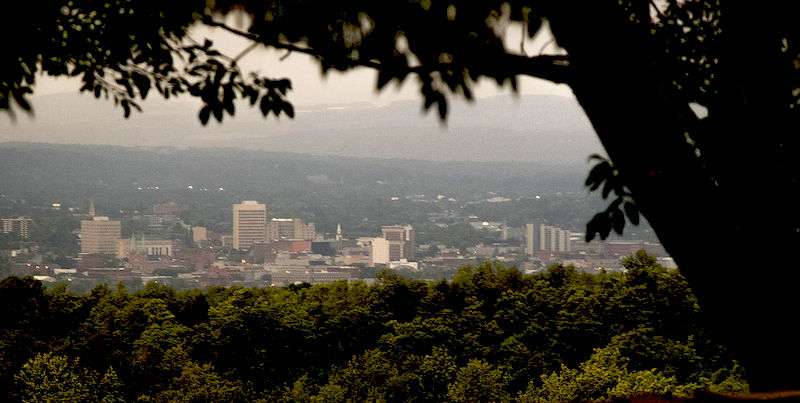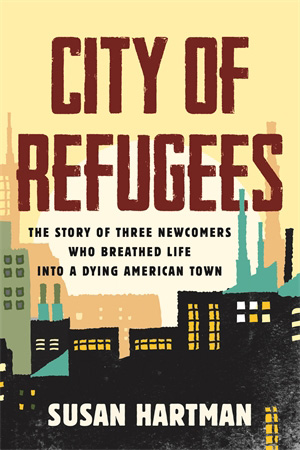How Utica Became a City Where Refugees Came to Rebuild

Utica became a refugee magnet by accident.
In the 1970s, Roberta Douglas, a local resident, became concerned about the mistreatment of Amerasian children in Vietnam. She helped one Amerasian resettle in Utica. Then along with Catholic Charities in Syracuse, she started resettling hundreds of Amerasians, and later, working with others, established the Mohawk Valley Resource Center for Refugees.
Over the next 40 years, there was a remarkable migration: Thousands of immigrants seeking sanctuary, including Vietnamese, Russians, and Burmese, have transformed this once-fading industrial town.
The newcomers make up about a quarter of Utica’s population of 60,000, according to Shelly Callahan, executive director of the Center for Refugees, recently renamed The Center, a nonprofit group that helps to resettle refugees and assist others in the community. And they have been an economic engine for the city, starting small businesses, renovating down-at-the-heels houses, opening houses of worship—and injecting a sense of vitality to its streets.
“It was so much more than economics,” John Zogby, the national pollster, said about the refugees’ effect on the city. “A whole generation couldn’t wait to get out. Then you had thousands of people who wanted to live here.”
“Other people started feeling good. It was infectious.”
*
The refugees came in waves: In the 1980s, people arrived from Vietnam, Cambodia, Laos, Poland, and the Soviet Union. Starting in the early 1990s, over 4,500 Bosnians fleeing the Balkan conflict became the largest group to be resettled.
In the last few years, there has been a sense of accomplishment and possibilities.In the 2000s, there was a surge of refugees from Burma—including the Karen, an ethnic minority persecuted by the Burmese military, who fled to camps in Thailand—and from Iraq, Nepal, Somalia, and Sudan. By 2019, more than 4,000 Karen and Burmese were resettled, becoming Utica’s second-largest group.
“The refugees helped stem the decline,” Ms. Callahan said. “They have a great work ethic and are willing to take jobs that native folks don’t want.” The refugee center helps cushion the landing: It spends about $1,100— federal and state money—on each refugee. Newcomers are given a furnished apartment, with the basics to get started.
Every refugee initially accesses public assistance—but is supposed to take the first viable job offered. “Refugees don’t come here to be on public assistance,” Ms. Callahan said. “That’s not the dream.”
Many currently work as dishwashers, groundskeepers, janitors, cooks, housekeepers, and card dealers at Turning Stone Resort Casino in Verona, New York. Others are employed at Chobani, the yogurt factory in New Berlin, owned by Hamdi Ulukaya, a Turkish immigrant. Chobani estimates that approximately 30 percent of its manufacturing workforce in New Berlin are immigrants or refugees.
The Bosnians have been the most successful group.
Many arrived with educations and building skills. “All of us had everything,” said Sefik Badnjevic, 62, a retired machinist, referring to the many middle-class lives uprooted by war. “We try to find here what we lost in Bosnia.”
Mr. Badnjevic was offended when his new neighbors asked questions like: “Did you have stores in your country? Did you have a TV?”
He would show them a video of his home, which he shot before the war: “This is my apartment! This is my car!” he said.
The Bosnians quickly adapted, often working two jobs to get ahead. Then in the late 1990s, there was a stunning confluence of events: The fires, which had been raging for decades, abated. The city tore down almost 200 vacant structures; the National Guard helped clear away the debris.
And the Bosnians bought hundreds of run-down houses in East Utica. The stage was set for what amounted to a massive rebuilding project: Bosnian families—sometimes three generations—did the work themselves. They tore out and rebuilt kitchens; they put in extra bedrooms. They fixed up garages, built decks, and planted gardens.
Many chose two-family homes, living in one as they rebuilt the other.
They often rented the second to parents or siblings.
Every Saturday, for seven years, Mr. Zogby gave a ride home to a Bosnian woman who worked for his family as a housekeeper; in Bosnia, she had been a police officer. One Saturday, she told him she had moved, and directed him to her new home.
“It was only a few blocks from where I had grown up,” Mr. Zogby said. It had been a photo studio, in a two-family house that had declined.
He pulled up to her new residence: She, her husband, and two tall sons had transformed it into a one-family home with white pillars.
“Outside was a massive American flag,” he recalled. “I knew what she was saying: ‘I turned this into my palace.’ ”
The Bosnians have now been in the city for two generations. They are doctors, nurses, physical therapists, contractors, police officers, firefighters, restaurateurs, bar owners, and restaurant managers. They work in Utica’s banks and at City Hall.
Many have stayed in their renovated homes—rather than move to New Hartford, an affluent suburb—even as new, struggling refugees have settled in their neighborhoods.
“If I sell my house, I’m selling my memories of my kids, my family,” said Sakib Duracak, 56, a contractor, who is the president of Bosnian Islamic Association of Utica. “I can’t remember seeing ‘House for Sale’ signs in Bosnia.”
In 2008, the community purchased the old, abandoned Central United Methodist Church from the city for a thousand dollars. It would have been costly for the city to demolish. Over the next four years, they built a soaring mosque downtown, doing the labor themselves.
Two other refugee groups that have been in Utica for more than a generation have also done well: The Vietnamese initially opened restaurants and food stores; most are now fully integrated into the community. Russians, who escaped religious persecution in the former Soviet Union, opened furniture stores and car dealerships.
For more recent arrivals, coming from refugee camps, “the learning curve has been longer, slower,” Ms. Callahan said. Yet the Karen, from the Karen state in southeastern Burma, have established a foothold, opening markets and buying homes.
The Somali Bantus—a community of about 2,000—have had a tougher time adapting.
In Somalia, the Bantus have long been persecuted. They are not seen as true Somalis, but as the descendants of slaves brought from other countries: In the 19th century, Arab slave traders brought Bantus to Somalia from southeast Africa to work on Somali plantations. Yet the largest group of Somali Bantus arrived thousands of years ago from West Africa, before the nomadic Somalis.
In recent years, the Somali Bantus worked small family farms, but they had little access to medical care, education, or jobs beyond manual labor.
They were powerless against armed Somalis: “If you were walking to a larger village, and met Somalis on the road, you could be taken and used to work their land,” said Mohamed Ganiso, 41, a community leader and the former director of the Somali Bantu Association of Central New York in Utica.
Armed Somalis sometimes took over the Bantus’ farms: Ahmed Mukonje, 46, who lives in Utica, was forced to be an unpaid laborer on his own land. “I was farming—but for them,” he said. “Slavery stopped when I got to the refugee camp.”
Clans provided an element of protection: “Everything is the clan,” said Mr. Ganiso, who is Halima’s nephew. “If a person in power was not in my clan, I didn’t trust them.” Disputes were brought before a community chief: “The chief decides what’s fair.”
Utica has always been a city of immigrants.For Somali Bantus, there was a deep sense of dislocation upon arrival in Utica. “The teachers sent home letters about the kids, but the parents couldn’t read them,” Mr. Ganiso said. “If they applied for a job they were told to go online, but they couldn’t.”
Uticans did not open their arms to the Somali Bantus, as they did for the Bosnians. “The Bosnians came with resources—and white skin,” said Dr. Kathryn Stam, the anthropology professor. “The Somali Bantus came with black skin, no education, and centuries of persecution. They were seen as backward.”
But in the last few years, there has been a sense of accomplishment and possibilities: Mr. Ganiso, who worked as a machinist at Chobani and now owns his own trucking company, estimated that unemployment in the Somali Bantu community, which was about 50 percent a decade ago, dropped to about 30 percent in 2019. That year, the unemployment rate in the Utica/Rome area was 4.7 percent.
More than half of Utica’s Somali Bantus own their own homes. Dozens of their children are now enrolled at MVCC and other colleges. “In the camps, we were almost not thinking,” Mr. Ganiso said, de-cribing the years Somali Bantus spent in limbo.
“Now everybody’s thinking about the future.”
*
Utica has always been a city of immigrants.
At the turn of the century, Italians, Germans, Poles, and Irish were drawn to Utica’s factories and mills.
They helped produce boots, screws, tools, hot air furnaces, cast-iron pipe, and beds. They made broom handles from logs that had been floated down the West Canada Creek from the Adirondacks and cut into lumber.
Utica’s large textile mills employed thousands of immigrants. The city was dubbed the Knit Goods Capital of the World. Women mostly worked in the woolen mills; men in the bleacheries. Utica Knitting Company, the city’s largest mill, was said to produce 34,000 pieces of underwear every 24 hours.
When the Italians started arriving in the 1880s, they found steady work and established a close-knit community in East Utica. Many soon began small businesses: “My great-grandfather was the first gentleman to walk up and down the streets of Utica yelling, ‘Lemon ice!’ ” said Anthony Amodio, 56, who works in the restaurant industry in Utica. Later, his grandfather opened a salumeria.
Lebanese and Syrian immigrants arrived around the same time, as part of peddling networks based in New York City and Boston; they sold linens and other dry goods. Many eventually opened grocery stores. By 1940, there were over 70 grocery stores owned by Syrians or Lebanese. Almost a quarter of the city’s population was foreign born, a similar ratio to the city’s refugee population today.
When Utica’s textile mills closed in the 1950s and relocated in the South, it wasn’t the tragedy it might have been. General Electric andother large manufacturing plants moved in. Picking up the slack, they replaced the 5,000 jobs immigrants had lost.
These jobs, too, would eventually vanish.
But in the 1960s, the city was still in bloom. And East Utica—to its immigrant families—was the center of the world.
“Houses were full, bursting!” said Mr. Zogby, who lived there for 36 years. “A family with four sons downstairs. Another with three sons upstairs.”
“It was a tough, none-of-your-shit culture. But as much as there was bullying going on, people had your back.”
Bleecker Street—a long, commercial strip—was the heart of the Italian community.
“There was everything here—you didn’t have to leave the street,” said Carmela Caruso, 62, a small, dark-haired woman who owns Caruso’s Pastry Shoppe on Bleecker Street, which her parents opened in 1958, said, “You could get your hair cut, your shoes shined and fixed.”
There were Italian restaurants and Syrian markets. A fish store served raw clams at sidewalk tables.
And there was a tradition: “Monday nights, that’s when people flocked downtown,” Ms. Caruso said.
All the stores stayed open late that night, and people strolled from Genesee Street down Bleecker. Starting in fourth grade, Ms. Caruso stayed up late, too. “I used to wait tables, make wedding favors, or do my homework, still wearing my Catholic school uniform.”
At 10:30 p.m., her dad and the other shop owners locked up. “Everybody walked home,” she said. “That was normal. That was our life.”
__________________________________

Excerpted from City of Refugees: The Story of Three Newcomers Who Breathed Life into a Dying American Town by Susan Hartman.
